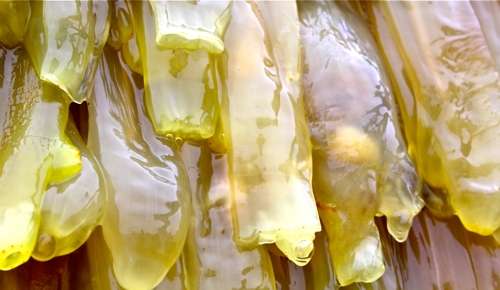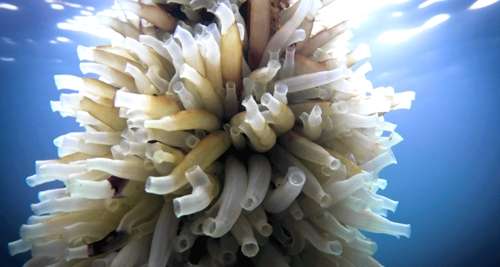A slimy marine organism fit for biofuel and salmon feed

(Phys.org) —It sounds too good to be true: a common marine species that consumes microorganisms and can be converted into much-needed feed for salmon or a combustible biofuel for filling petrol tanks. And it can be cultivated in vast amounts: 200 kg per square metre of ocean surface area.
Tunicates (ciona intestinalis) is the name of this unexpected source of such rich potential. The species is the starting point for a research-based innovation project being carried out by researchers and innovation specialists in Bergen. The idea was hatched by a group of researchers at the University of Bergen and Uni Research.
Produces cellulose and contains omega-3
The yellowish, slimy growth that many of us have come across on ropes that have lain in seawater is the marine organism known as tunicates.
Tunicates are basically living filter tubes that suck bacteria and other microorganisms into one end and excrete purified water out the other end. This is how tunicates feed – at the very bottom of the food chain and without competing directly with fish or other marine animals higher up in the chain. At the same time tunicates clean the fjords and coastal areas.
The fact that tunicates are also the only animals that produce cellulose – and that they are rich in omega-3 fatty acids – makes them a potential alternative for bioethanol and as a feed ingredient for farmed fish.
Inhabiting all oceans
Tunicates grow very quickly and year-round. Found in every ocean, they particularly thrive in cold, nutrient-rich waters such as those around the quays and coastal rock slopes of Western Norway.
Since there are no marine predators feeding on tunicates, some 2 500 to 10 000 individuals can grow undisturbed in 1 m2 of ocean surface area.
Other than the Japanese and Koreans, who eat tunicates, no one has paid them much attention until now.
Similar to mussel cultivation
For the first time ever, tunicates are being cultivated experimentally at a pilot facility in Øygarden, a small island community near Bergen.
The production method resembles the cultivation of mussels. At a facility in a small finger of a fjord, long plastic sheets are anchored to the seabed and held vertical by buoys. Between these sheets flows seawater teeming with the microorganisms tunicates need.

The Research Council of Norway's programme Commercialising R&D Results (FORNY2020) and the technology transfer office Bergen Teknologioverføring (BTO) are investing heavily to scale up tunicate production. Christofer Troedsson of Uni Research is the project manager. The project will run through 2014.
Those involved have known all along that the project is high-risk. But many of the risky components have now been tested, and it has been verified that they function as intended. And if all goes as planned, as it looks like it will, the results may be impressive.
From cellulose to bioethanol
The tunicate is the only animal known to produce cellulose, with which it constructs its body wall, called the mantle.
Breaking down cellulose yields sugars that can be used to produce the fuel bioethanol. Much of the world's bioethanol currently comes from corn, a controversial source since this crop could be used to feed people instead.
One alternative being thoroughly researched is to produce bioethanol from the cellulose in forest-based biomass. But this is not unproblematic either, since the biopolymer lignin contained in wood is valuable in many other applications. Tunicate cellulose would be a less controversial source because it does not contain lignin.
Targeting fish feed based on marine ingredients
Even more attractive than biofuel production is the use of tunicates in feed for salmon and other farmed fish. Norway is the world's largest producer of salmon feed, and there is a huge demand for more marine proteins as feed ingredients, but the limit has already been reached in industrialised fishing.
One major challenge facing feed producers is to produce salmon feed containing omega-3 fatty acids, which the fish need but do not generate. The bulk of omega-3 in salmon feed presently comes from the fisheries industry. Dried tunicates contain 60 per cent protein and are rich in omega-3. Perhaps just as importantly, salmon find them tasty as well.
So tunicates appear promising as a new feed ingredient.
Large-scale cultivation needed
Protein production from marine cultivation of tunicates has 100 times the potential per square metre than any land-based protein cultivation. Moreover, the food that tunicates need is readily available in the form of vast amounts of microorganisms in nutrient-rich marine waters.
So what is the hold-up?
"Our single greatest challenge is cultivating enough biomass per square metre to make operations profitable," explains project manager Troedsson. "We anticipate a crop of 100 to 200 kilograms per square metre, which is an extremely high yield. But that is what is needed for profitability because the price per kilo is so low."
The Bergen-based researchers have achieved this production target at their small-scale facility, and the mathematical models they have run make them optimistic that a similar production level is possible with large-scale tunicate farms. But there are no guarantees just yet.
Removing the water
"The second major challenge we face is how much water we can squeeze out of the tunicates," continues Dr Troedsson. "Their body mass is 95 per cent water. To sell the product we have to be able to remove at least 90 per cent and preferably 95 per cent of that water by mechanical pressing."
"On an isolated basis we have managed to mechanically press out 97 per cent of the water. Now we must try to carry out that process efficiently on board the harvesting boats, while at the same time pulling several tonnes of tunicates per hour out of the sea."
"Thus production volume and water separation are the two critical factors that must be successfully addressed if tunicate cultivation is to be profitable for private companies in today's market," concludes Dr Troedsson.
Provided by The Research Council of Norway











.jpg)






